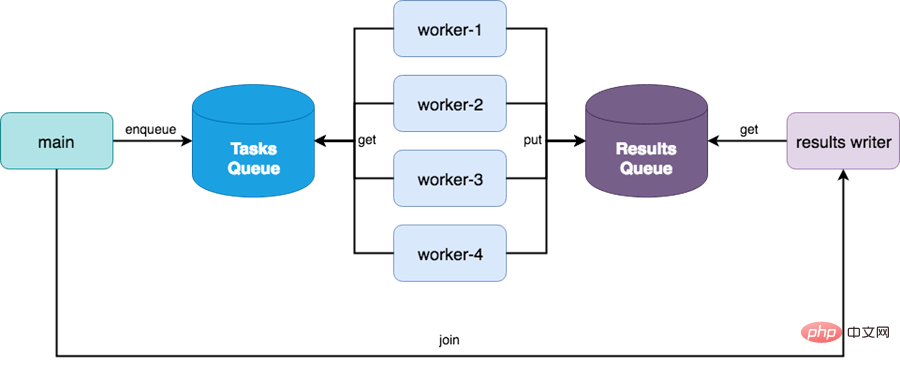No waiting to be written or thrown |
|
说明:
put(), get() 是阻塞方法, 而put_notwait(), get_nowait()是非阻塞方法。
Multiprocessing 的Queue类没有提供Task_done, join方法
Queue模块的其它队列类:
(1) SimpleQueue
简洁版的FIFO队列, 适事简单场景使用
(2) JoinableQueue子类
Python 3.5 后新增的 Queue的子类,拥有 task_done(), join() 方法
producer – consumer 场景,使用Queue的示例
import multiprocessing
def producer(numbers, q):
for x in numbers:
if x % 2 == 0:
if q.full():
print("queue is full")
break
q.put(x)
print(f"put {x} in queue by producer")
return None
def consumer(q):
while not q.empty():
print(f"take data {q.get()} from queue by consumer")
return None
if __name__ == "__main__":
# 设置1个queue对象,最大长度为5
qu = multiprocessing.Queue(maxsize=5,)
# 创建producer子进程,把queue做为其中1个参数传给它,该进程负责写
p5 = multiprocessing.Process(
name="producer-1",
target=producer,
args=([random.randint(1, 100) for i in range(0, 10)], qu)
)
p5.start()
p5.join()
#创建consumer子进程,把queue做为1个参数传给它,该进程中队列中读
p6 = multiprocessing.Process(
name="consumer-1",
target=consumer,
args=(qu,)
)
p6.start()
p6.join()
print(qu.qsize())4、同步机制通信
(1) 进程间同步锁 – Lock
Multiprocessing也提供了与threading 类似的同步锁机制,确保某个时刻只有1个子进程可以访问某个资源或执行某项任务, 以避免同抢。
例如:多个子进程同时访问数据库表时,如果没有同步锁,用户A修改1条数据后,还未提交,此时,用户B也进行了修改,可以预见,用户A提交的将是B个修改的数据。
添加了同步锁,可以确保同时只有1个子进程能够进行写入数据库与提交操作。
如下面的示例,同时只有1个进程可以执行打印操作。
from multiprocessing import Process, Lock
def f(l, i):
l.acquire()
try:
print('hello world', i)
finally:
l.release()
if __name__ == '__main__':
lock = Lock()
for num in range(10):
Process(target=f, args=(lock, num)).start()(2) 子进程间协调机制 – Event
Event 机制的工作原理:
1个event 对象实例管理着1个 flag标记, 可以用set()方法将其置为true, 用clear()方法将其置为false, 使用wait()将阻塞当前子进程,直至flag被置为true.
这样由1个进程通过event flag 就可以控制、协调各子进程运行。
Event object的使用方法:
1)主函数: 创建1个event 对象, flag = multiprocessing.Event() , 做为参数传给各子进程
2) 子进程A: 不受event影响,通过event 控制其它进程的运行
o 先clear(),将event 置为False, 占用运行权.
o 完成工作后,用set()把flag置为True。
3) 子进程B, C: 受event 影响
o 设置 wait() 状态,暂停运行
o 直到flag重新变为True,恢复运行
主要方法:
set(), clear()设置 True/False,
wait() 使进程等待,直到flag被改为true.
is_set(), Return True if and only if the internal flag is true.
验证进程间通信 – Event
import multiprocessing
import time
import random
def joo_a(q, ev):
print("subprocess joo_a start")
if not ev.is_set():
ev.wait()
q.put(random.randint(1, 100))
print("subprocess joo_a ended")
def joo_b(q, ev):
print("subprocess joo_b start")
ev.clear()
time.sleep(2)
q.put(random.randint(200, 300))
ev.set()
print("subprocess joo_b ended")
def main_event():
qu = multiprocessing.Queue()
ev = multiprocessing.Event()
sub_a = multiprocessing.Process(target=joo_a, args=(qu, ev))
sub_b = multiprocessing.Process(target=joo_b, args=(qu, ev,))
sub_a.start()
sub_b.start()
# ev.set()
sub_a.join()
sub_b.join()
while not qu.empty():
print(qu.get())
if __name__ == "__main__":
main_event()5、共享内存方式通信
(1) 共享变量
子进程之间共存内存变量,要用 multiprocessing.Value(), Array() 来定义变量。 实际上是ctypes 类型,由multiprocessing.sharedctypes模块提供相关功能
注意 使用 share memory 要考虑同抢等问题,释放等问题,需要手工实现。因此在使用共享变量时,建议使用Manager管程来管理这些共享变量。
def func(num):
num.value=10.78 #子进程改变数值的值,主进程跟着改变
if __name__=="__main__":
num = multiprocessing.Value("d", 10.0)
# d表示数值,主进程与子进程可共享这个变量。
p=multiprocessing.Process(target=func,args=(num,))
p.start()
p.join()
print(num.value)进程之间共享数据(数组型):
import multiprocessing
def func(num):
num[2]=9999 #子进程改变数组,主进程跟着改变
if __name__=="__main__":
num=multiprocessing.Array("i",[1,2,3,4,5])
p=multiprocessing.Process(target=func,args=(num,))
p.start()
p.join()
print(num[:])(2) 共享内存 Shared_memory
如果进程间需要共享对象数据,或共享内容,数据较大,multiprocessing 提供了SharedMemory类来实现进程间实时通信,不需要通过发消息,读写磁盘文件来实现,速度更快。
注意:直接使用SharedMemory 存在着同抢、泄露隐患,应通过SharedMemory Manager 管程类来使用, 以确保内存安全。
创建共享内存区:
multiprocessing.shared_memory.SharedMemory(name=none, create=False, size=0)
方法:
父进程创建shared_memory 后,子进程可以使用它,当不再需要后,使用close(), 删除使用unlink()方法
相关属性:
获取内存区内容: shm.buf
获取内存区名称: shm.name
获取内存区字节数: shm.size
示例:
>>> from multiprocessing import shared_memory
>>> shm_a = shared_memory.SharedMemory(create=True, size=10)
>>> type(shm_a.buf)
>>> buffer = shm_a.buf
>>> len(buffer)
10
>>> buffer[:4] = bytearray([22, 33, 44, 55]) # Modify multiple at once
>>> buffer[4] = 100 # Modify single byte at a time
>>> # Attach to an existing shared memory block
>>> shm_b = shared_memory.SharedMemory(shm_a.name)
>>> import array
>>> array.array('b', shm_b.buf[:5]) # Copy the data into a new array.array
array('b', [22, 33, 44, 55, 100])
>>> shm_b.buf[:5] = b'howdy' # Modify via shm_b using bytes
>>> bytes(shm_a.buf[:5]) # Access via shm_a
b'howdy'
>>> shm_b.close() # Close each SharedMemory instance
>>> shm_a.close()
>>> shm_a.unlink() # Call unlink only once to release the shared memory
3) ShareableList 共享列表
sharedMemory类还提供了1个共享列表类型,这样就更方便了,进程间可以直接共享python强大的列表
构建方法:
multiprocessing.shared_memory.ShareableList(sequence=None, *, name=None)
from multiprocessing import shared_memory
>>> a = shared_memory.ShareableList(['howdy', b'HoWdY', -273.154, 100, None, True, 42])
>>> [ type(entry) for entry in a ]
[, , , , , , ]
>>> a[2]
-273.154
>>> a[2] = -78.5
>>> a[2]
-78.5
>>> a[2] = 'dry ice' # Changing data types is supported as well
>>> a[2]
'dry ice'
>>> a[2] = 'larger than previously allocated storage space'
Traceback (most recent call last):
...
ValueError: exceeds available storage for existing str
>>> a[2]
'dry ice'
>>> len(a)
7
>>> a.index(42)
6
>>> a.count(b'howdy')
0
>>> a.count(b'HoWdY')
1
>>> a.shm.close()
>>> a.shm.unlink()
>>> del a # Use of a ShareableList after call to unlink() is unsupported
b = shared_memory.ShareableList(range(5)) # In a first process
>>> c = shared_memory.ShareableList(name=b.shm.name) # In a second process
>>> c
ShareableList([0, 1, 2, 3, 4], name='...')
>>> c[-1] = -999
>>> b[-1]
-999
>>> b.shm.close()
>>> c.shm.close()
>>> c.shm.unlink()
6、共享内存管理器Manager
Multiprocessing 提供了 Manager 内存管理器类,当调用1个Manager实例对象的start()方法时,会创建1个manager进程,其唯一目的就是管理共享内存, 避免出现进程间共享数据不同步,内存泄露等现象。
其原理如下:

Manager管理器相当于提供了1个共享内存的服务,不仅可以被主进程创建的多个子进程使用,还可以被其它进程访问,甚至跨网络访问。本文仅聚焦于由单一主进程创建的各进程之间的通信。
1) Manager的主要数据结构
相关类:multiprocessing.Manager
子类有:
支持共享变量类型:
python基本类型 int, str, list, tuple, list
进程通信对象: Queue, Lock, Event,
Condition, Semaphore, Barrier ctypes类型: Value, Array
2) 使用步骤
1)创建管理器对象
snm = Manager()
snm = SharedMemoryManager()
2)创建共享内存变量
新建list, dict
sl = snm.list(), snm.dict()
新建1块bytes共享内存变量,需要指定大小
sx = snm.SharedMemory(size)
新建1个共享列表变量,可用列表来初始化
sl = snm.ShareableList(sequence) 如
sl = smm.ShareableList([‘howdy', b'HoWdY', -273.154, 100, True])
新建1个queue, 使用multiprocessing 的Queue类型
snm = Manager()
q = snm.Queue()
示例 :
from multiprocessing import Process, Manager
def f(d, l):
d[1] = '1'
d['2'] = 2
d[0.25] = None
l.reverse()
if __name__ == '__main__':
with Manager() as manager:
d = manager.dict()
l = manager.list(range(10))
p = Process(target=f, args=(d, l))
p.start()
p.join()
print(d)
print(l)将打印
{0.25: None, 1: '1', '2': 2}
[9, 8, 7, 6, 5, 4, 3, 2, 1, 0]
3) 销毁共享内存变量
方法一:
调用snm.shutdown()方法,会自动调用每个内存块的unlink()方法释放内存。或者 snm.close()
方法二:
使用with语句,结束后会自动释放所有manager变量
>>> with SharedMemoryManager() as smm:
... sl = smm.ShareableList(range(2000))
... # Divide the work among two processes, storing partial results in sl
... p1 = Process(target=do_work, args=(sl, 0, 1000))
... p2 = Process(target=do_work, args=(sl, 1000, 2000))
... p1.start()
... p2.start() # A multiprocessing.Pool might be more efficient
... p1.join()
... p2.join() # Wait for all work to complete in both processes
... total_result = sum(sl) # Consolidate the partial results now in sl
4) 向管理器注册自定义类型
managers的子类BaseManager提供register()方法,支持注册自定义数据类型。如下例,注册1个自定义MathsClass类,并生成实例。
from multiprocessing.managers import BaseManager
class MathsClass:
def add(self, x, y):
return x + y
def mul(self, x, y):
return x * y
class MyManager(BaseManager):
pass
MyManager.register('Maths', MathsClass)
if __name__ == '__main__':
with MyManager() as manager:
maths = manager.Maths()
print(maths.add(4, 3)) # prints 7
print(maths.mul(7, 8))
 In actual project requirements, there are often intensive calculations or real-time tasks, and sometimes a large amount of data needs to be transferred between processes, such as pictures, large objects, etc.
In actual project requirements, there are often intensive calculations or real-time tasks, and sometimes a large amount of data needs to be transferred between processes, such as pictures, large objects, etc. About inter-process Memory safety of communication
About inter-process Memory safety of communication Queue module provides a total of 3 types of queues.
Queue module provides a total of 3 types of queues.